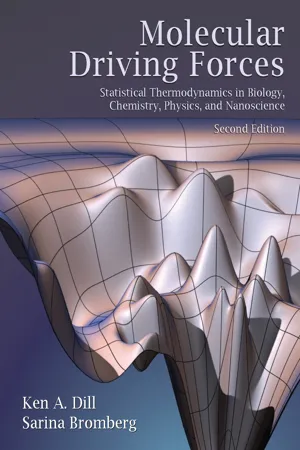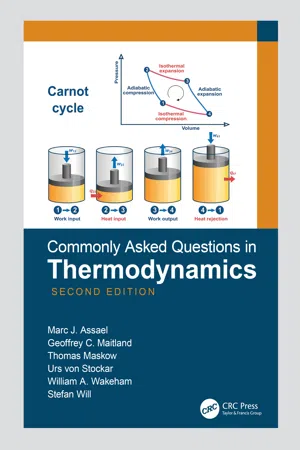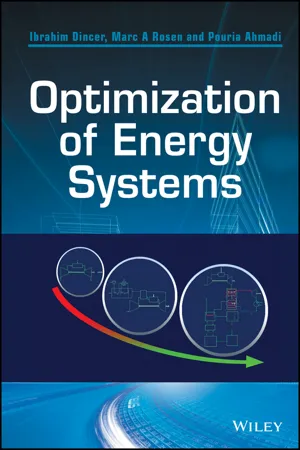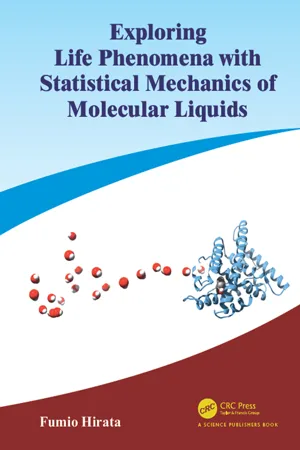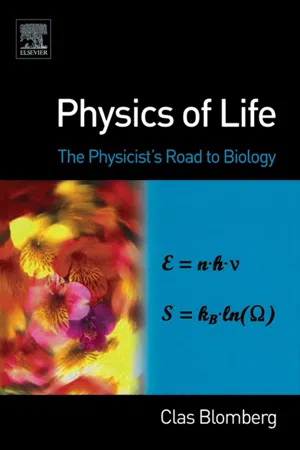Physics
Thermodynamic Force
Thermodynamic force refers to a driving force that causes a system to undergo a change in its thermodynamic state. It is associated with the flow of energy or matter and is often used to describe the tendency of a system to move towards equilibrium. In thermodynamics, these forces play a crucial role in understanding and predicting the behavior of physical systems.
Written by Perlego with AI-assistance
Related key terms
Related key terms
1 of 4
Related key terms
1 of 3
8 Key excerpts on "Thermodynamic Force"
- eBook - ePub
Molecular Driving Forces
Statistical Thermodynamics in Biology, Chemistry, Physics, and Nanoscience
- Ken Dill, Sarina Bromberg(Authors)
- 2010(Publication Date)
- Garland Science(Publisher)
6 Thermodynamic Driving Forces Thermodynamics Is Two Laws and a Little CalculusThermodynamics is a set of tools for reasoning about energies and entropies. It enables you to predict the tendencies of atoms and molecules to react; to bind, absorb, or partition; to dissolve or change phase; and to change their shapes or chemical bonds. The three basic tools of thermodynamics are the First Law for the conservation of energy (see Chapter 3 ), the maximum entropy principle, also called the Second Law of Thermodynamics (Chapters 2 and 5 ), and multivariate calculus (Chapter 4 ). In this chapter, we explore the definitions of the forces that act in material systems: pressure, the tendency to exchange volume; temperature, the tendency to exchange energy; and chemical potential, the tendency to exchange matter or to change its form.What Is a Thermodynamic System?A thermodynamic system is a collection of matter in any form, delineated from its surroundings by real or imaginary boundaries. The system may be a biological cell, the contents of a test tube, the gas in a piston, a thin film, or a can of soup. How you define a system depends on the problem that you want to solve. In thermodynamics, defining the boundaries is important, because boundaries determine what goes in or out. Much of thermodynamics is bookkeeping, accounting for energy or matter exchange across the boundaries or for volume changes. For a biochemical experiment, the boundary might be the walls of a test tube or a cell membrane. For a steam engine, the interior of the piston might be the most convenient definition of the system. The boundary need not be fixed in space. It need not even surround a fixed number of molecules. The system might contain subsystems, and the subsystems might also be delineated by real or imaginary boundaries. Systems are defined by the nature of their boundaries:OPEN SYSTEM . An open system can exchange energy, volume, and matter with its surroundings. The Earth and living organisms are open systems (see Figure 6.1 - eBook - ePub
Electrochemical Energy Storage
Physics and Chemistry of Batteries
- Reinhart Job(Author)
- 2020(Publication Date)
- De Gruyter(Publisher)
2 ThermodynamicsThermodynamics is a fundamental part of classical physics. It is a closed theory describing macroscopic physical properties – such as the internal energy, entropy, pressure and volume – of matter (and radiation). Thermodynamics shows that the physical properties of matter are subject to general constraints that are common to all substances and materials; anyhow, the appearances of particular properties of specific substances and materials are different. The fundamental constraints are expressed in the thermodynamic laws. These laws completely rule our macroscopic world; and they are described further briefly in this chapter.Thermodynamics is the base of a large variety of topics in science and engineering. It is fundamental for mechanical and chemical engineering. In particular, it describes physical and chemical equilibrium states, and therefore, it is very important for chemistry and chemical reactions. With the help of experimentally measured thermal data, energetic changes of matter and systems can be calculated, and hence, a change of equilibrium states or phase transitions can be predicted and simulated. The same holds for the chemical reactions and processes. Altogether, thermodynamics has a very strong practical relevance in chemistry and engineering.Before we discuss the fundamental four laws of thermodynamics, in the following subsection, we introduce a variety of physical terms and definitions, which are necessary for the later explanations.2.1 Terms and definitions
Dealing with thermodynamics requires a set of definitions and a good understanding of the physical terms and wordings, which has to be clarified before further explanations and discussions are presented.2.1.1 Systems
A system is a macroscopically spatially well-defined part of the universe. It is the special part of the universe that is to be studied or analyzed, and it is separated from the surroundings (Figure 2.1 - eBook - ePub
- Nils O. Petersen(Author)
- 2017(Publication Date)
- CRC Press(Publisher)
6The basics of thermodynamics
6.1 SOME BASIC CONCEPTS
Thermodynamics refers to the field of chemistry which is concerned with understanding the flow of energy within a system or when a system changes from one state to another. One ultimate purpose of thermodynamics is to predict whether a change will occur spontaneously. The field of thermodynamics is based on three fundamental laws which lead to a set of parameters such as the free energy and the chemical potential, which are key to our understanding of spontaneous change.In contrast to the field of quantum mechanics, the field of thermodynamics is, to a first approximation, not concerned with the detailed structures of the materials, and hence the outcomes become very generally applicable.Our first task is to remind ourselves of some basic concepts of systems and how we describe these.A system is simply that region of space or matter that we are interested in understanding. The surroundings of the system is everything else —in principle, everything else in the universe, but in practice everything else that matters, such as the laboratory in which we study the system. For example, the system could be a gas held in a glass container, with the surroundings being the glass container and everything around it. Similarly, the system could be a solution of molecules in a solvent where the system is the molecules in solution and the surroundings include the solvent, the container and everything around it.We characterize a system by a number of functions (or variables) that tell us something unique about the system. Examples would be the temperature of the system, the pressure of the system, the volume of the system, the mass (or the number of molecules) in the system, and the energy of the system. If the state of the system changes, we expect one or more of these functions to change as well, for example, if the number of molecules in the system changes, the volume might change; or if a chemical reaction occurs, the temperature might change. In the context of thermodynamics we are most interested in understanding the change in energy, which is in turn often related to the changes in temperature, pressure, volume, and mass. - eBook - ePub
- Marc J. Assael, Geoffrey C. Maitland, Thomas Maskow, Urs von Stockar, William A. Wakeham, Stefan Will(Authors)
- 2022(Publication Date)
- CRC Press(Publisher)
1 Definitions and the First Law of ThermodynamicsDOI: 10.1201/9780429329524-11.1 Introduction
The subjects of thermodynamics, statistical mechanics, kinetic theory and transport phenomena are almost universal within university courses in physical, chemical and biological sciences and engineering. The intensity with which these topics are studied as well as the balance between them varies considerably by discipline. However, to some extent, the development and indeed ultimate practice of these disciplines requires thermodynamics as a foundation. It is therefore rather more than unfortunate that for many studying courses in one or more of these topics thermodynamics present a very great challenge. It is often argued by students that the topics are particularly difficult and abstract with a large amount of complicated mathematics and rather few practical examples that arise in everyday life. Probably for this reason, surveys of students reveal that most strive simply to learn enough to pass the requisite examination but do not attempt serious understanding. However, our lives use and require energy, its conversion in a variety of forms and understanding these processes is intimately connected to thermodynamics and transport phenomena (the transport of mass, momentum or energy). For example, whether a proposed new source of energy or a new product is genuinely renewable and/or carbon-neutral, depends greatly on a global energy balance, on the processes of its production and its interaction with the environment. This analysis is necessarily based on the laws of thermodynamics, which makes it even more important now for all scientists and engineers to have a full appreciation of these subjects as they seek to grapple with increasingly complex and interconnected problems.This book sets out to provide answers to some of the questions that undergraduate students and new researchers raise about thermodynamics. The list of topics is therefore rather eclectic and, perhaps in some sense, not entirely coherent. It is certainly true that the reader of any level should not expect to “learn” any of these subjects from this book alone. It is, instead, intended to complement existing texts, dealing in greater detail and in a different way with “some” of the topics deemed least straightforward by our own students over many years. If you do not find the question you have treated in this text, then we apologize. Alternative sources of information include Sandler (1989) , Levenspiel (1996) , Cengel and Boles (2014) , Sonntag et al. (2003) , Smith (2013) , Smith et al. (2017) , Moran et al. (2018) and Grossman (2020) - eBook - ePub
- Ibrahim Dinçer, Marc A. Rosen, Pouria Ahmadi(Authors)
- 2017(Publication Date)
- Wiley(Publisher)
Although energy can be transformed into different forms, the principle of conservation of energy states that the total energy of a system can only change if energy is transferred into or out of the system. This implies that it is impossible to create or destroy energy. The total energy of a system can this be calculated by adding all forms of energy in the system. Examples of energy transfer and transformation include generating or making use of electric energy, performing chemical reactions and lifting an object. Lifting against gravity performs work on the object and stores gravitational potential energy; if the object falls, gravity does work on the object, which transforms its potential energy into kinetic energy associated with its speed.The name “thermodynamics” stems from the Greek words therme (heat) and dynamis (power), which is descriptive of efforts to convert heat into power [1]. The discipline of thermodynamics is based primarily on two fundamental natural laws, known as the first and second laws. The first law of thermodynamics is simply an expression of the conservation of energy principle. It states that energy, as a thermodynamic quantity, is neither created nor destroyed during a process. The second law of thermodynamics states that energy has quality as well as quantity, and that processes naturally occur in the direction of decreasing quality of energy [2].1.3 The First Law of Thermodynamics
The first law of thermodynamics (FLT) embodies the principle of energy conservation, which states that, although energy can change form, it can be neither created nor destroyed. The FLT defines internal energy as a state function and provides a formal statement of the conservation of energy [2]. However, the first law provides no information about the direction in which processes can spontaneously occur, that is, reversibility aspects of thermodynamic processes. For example, the FLT cannot indicate how cells can perform work while existing in an isothermal environment. The FLT provides no information about the inability of any thermodynamic process to convert heat fully into mechanical work, or any insight into why mixtures cannot spontaneously separate or unmix themselves. A principle to explain these phenomena and to characterize the availability of energy is required. Such a principle is embodied in the second law of thermodynamics (SLT), which we explain later in this chapter. - eBook - ePub
The Language of Modern Physics
An Introduction to the Philosophy of Science
- Ernest H. Hutten(Author)
- 2022(Publication Date)
- Routledge(Publisher)
But thermodynamics is more general in scope; it uses the wider concept of energy to describe the behaviour of all sorts of systems. Heat phenomena are not of the same kind as mechanical or electric phenomena—they deal with systems rather than with individual masses or charges. It is a strange idea indeed that heat is regarded as being a separate phenomenon: as if only special systems exhibited the property of temperature. But the state of all systems must be described, among other variables, by the variable referring to temperature; not only mechanical, but electric, magnetic, and even quantum-mechanical systems possess this property, while ‘mass’, ‘charge’, and so on, are terms applicable only to certain systems. However, when we do an experiment at a moderate temperature, the thermal effect on any system is negligible; mainly for very low or very high temperatures do we find, experimentally, that temperature plays a decisive rôle in the physical process. Such extremes of temperature are practically difficult to produce so that we tend to forget them.Thermodynamics describes the general behaviour of systems, and it applies both to microscopic and macroscopic phenomena, to field physics as well as to quantum physics. The concept of system is applicable everywhere, and it suggests immediately large-scale phenomena and the statistical distribution of events. It is of course the concept of probability, and the statistical interpretation, that ultimately reveal the peculiar character of thermodynamics.2. The conservation of energy
Poincaré once remarked that the scientist who first introduced the noun ‘heat’ to describe temperature phenomena has done a great disservice to science. For it suggests that heat is a substance, so that the ‘flow of heat’ is a phrase referring to a process similar to that of the flow of water. The caloric theory of heat was the outcome of this interpretation; unfortunately, we have retained some of the principal terms of the theory up to the present day, and this does not help in making clearer our ideas about heat. But, in some sense, this view is inevitable; it is in accord with the common sense interpretation underlying the thing-language of daily life. It suggests the simplest kind of semantic system, or model, and so provides implicitly some rules for the use of certain terms within a limited context. The concepts of specific heat or latent heat, etc., belong to this interpretation, and they have been used with great success. This ‘fluid’ model must be recognised as a tacit assumption for some statements of thermodynamics.The next step in the development, say Rumford’s experiments, show that heat may be interpreted as a motion of the particles which make up a body. This molecular conception of heat as a kind of motion is said to go back to the ancients; it relates heat to the particle model of mechanics. Again, it was perhaps unfortunate that temperature phenomena were described, mainly, in terms of mechanics so that, even to-day, we find it difficult to interpret thermodynamics except in these terms; but temperature is a universal characteristic and it applies to every kind of physical process. - eBook - ePub
Exploring Life Phenomena with Statistical Mechanics of Molecular Liquids
Exploring Life Phenomena
- Fumio Hirata(Author)
- 2020(Publication Date)
- CRC Press(Publisher)
IFundamentals:
Basic Concepts Related to Statistical Mechanics
This chapter is devoted to review some basic concepts related to the statistical mechanics, which are crucial for the readers to understand contents in the succeeding chapters.I-1 Thermodynamics
Thermodynamics is the most fundamental field of science on which all other fields of science, including the life science, is based. Here, we briefly review the field of science. The theory of thermodynamics was developed during the 19th century by many giants in science including Kelvin, Clasius, and Carnot, mainly motivated by improvement of the efficiency of the steam engine. A steam engine is a simple devise consisting of a cylinder and a piston, in which water is confined. When water inside the cylinder is heated up, it is evaporated to produce vapor in the cylinder. Since the vapor has large molar volume, it pushes the piston against the atmospheric pressure. The motion of the piston is mechanically transmitted to rotate the wheel of vehicle. Therefore, the principle of steam engine is to convert one kind of energy, or heat, to the other kind of energy called “work.” So, the thermodynamics was originally developed for improving the efficiency of the engine to convert heat to work. There are essentially two laws in thermodynamics: the first law and the second law.The First Law: The first law of thermodynamics is a statement of the principle of energy conservation. Suppose a system consisting of molecules included in a container, the volume of which is V, is in contact with an “environment.” The system can exchange energy with the environment in two forms: heat and work. Let us write the exchange of energy as,d E = d ′ Q + d ′ W(I-1.1) where E denotes the (internal) energy of the system, d’Q and d’W - eBook - ePub
Physics of Life
The Physicist's Road to Biology
- Clas Blomberg(Author)
- 2007(Publication Date)
- Elsevier Science(Publisher)
The view presented in the first section with a two-level microscopic/macroscopic description of nature will be followed up and further developed in this section. Indeed, the microscopic view can be regarded as the most fundamental and one in which energies and forces should be most clear. Indeed, for the applications to processes of life, we may well state that everything in the reductionism low-level picture goes back to electrodynamics, primary electrostatic forces and energies. There are electrostatic forces that keep the biological molecules together and also provide mutual forces, thus directing their motion in cells.The gravitation force is probably the force that appears most evident for us, the one that makes objects fall to the floor, makes difficulties for us to stand upright and that makes the moon to encircle the earth and the earth to encircle the sun. Certainly a force that is very relevant, but unlike the other kinds of forces, this is a force that is relevant at the macroscopic level. Gravitation forces are very small at an atomic/molecular level and play a small role at the cell level. As I choose to put the emphasis on the molecularly based processes of the cells, they become less relevant for our account.It is necessary to make a choice, and I also avoid hydrodynamic and elasticity questions; relevant questions but quite different from those that I take up.By all standards, the most important kind of forces in our framework here are the electrical ones, and we will take up electrodynamics in some detail. We can well claim that everything is electrically governed.We start with general accounts of classical mechanics and electromagnetism. What becomes an important theme for this book is thermodynamics, and general accounts are given in this section together with a first account of the statistical-microscopic concepts. These will be developed and applied in later sections.In this section, we also provide a rather broad account of quantum mechanics. Quantum mechanics is crucial for describing how molecules are kept together. Quantum mechanics is also crucial for describing chemical reactions and electron transfer, normally the basic feature of a reaction. Indeed, we cannot understand the low-level structure of any matter and the effect of electromagnetism unless we go to quantum mechanics. Matter would not be stable in a Newtonian classical framework. This statement will be discussed in this section in relation to thermodynamics and the low-level formalism. This is perhaps not the most common view on the road to quantum mechanics, but it certainly contains aspects that were very important for the 20th century physics, and it suits well in our themes here. I will in this section also show a relevant example of quantum mechanical formalism of the hydrogen atom. Although quantum mechanics forms an important background and aspects will be discussed in later sections, that part will not be developed further, and is therefore, in contrast to the thermodynamics chapter more complete at this first stage.
Index pages curate the most relevant extracts from our library of academic textbooks. They’ve been created using an in-house natural language model (NLM), each adding context and meaning to key research topics.
Explore more topic indexes
Explore more topic indexes
1 of 6
Explore more topic indexes
1 of 4
